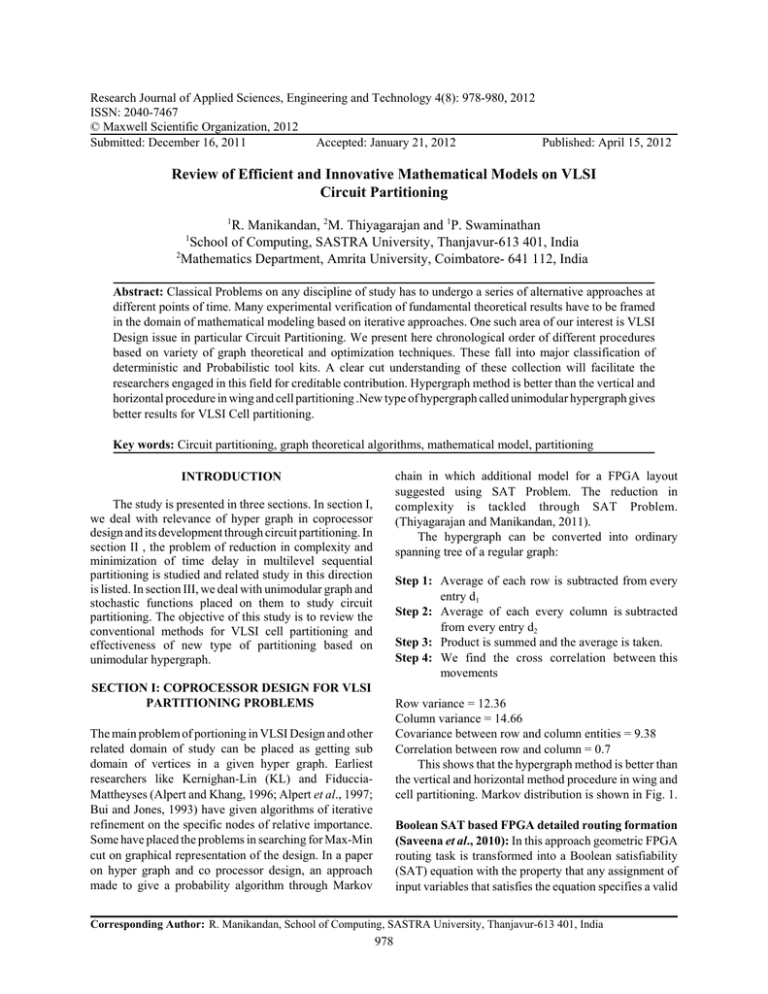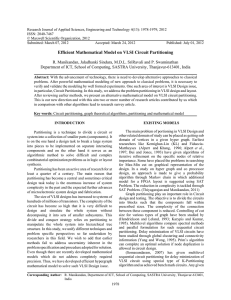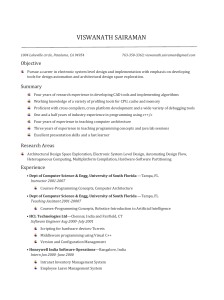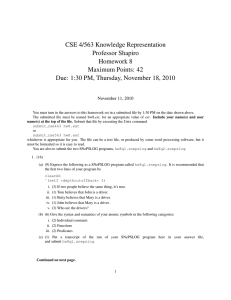Research Journal of Applied Sciences, Engineering and Technology 4(8): 978-980,... ISSN: 2040-7467 © Maxwell Scientific Organization, 2012
advertisement

Research Journal of Applied Sciences, Engineering and Technology 4(8): 978-980, 2012
ISSN: 2040-7467
© Maxwell Scientific Organization, 2012
Submitted: December 16, 2011
Accepted: January 21, 2012
Published: April 15, 2012
Review of Efficient and Innovative Mathematical Models on VLSI
Circuit Partitioning
1
R. Manikandan, 2M. Thiyagarajan and 1P. Swaminathan
1
School of Computing, SASTRA University, Thanjavur-613 401, India
2
Mathematics Department, Amrita University, Coimbatore- 641 112, India
Abstract: Classical Problems on any discipline of study has to undergo a series of alternative approaches at
different points of time. Many experimental verification of fundamental theoretical results have to be framed
in the domain of mathematical modeling based on iterative approaches. One such area of our interest is VLSI
Design issue in particular Circuit Partitioning. We present here chronological order of different procedures
based on variety of graph theoretical and optimization techniques. These fall into major classification of
deterministic and Probabilistic tool kits. A clear cut understanding of these collection will facilitate the
researchers engaged in this field for creditable contribution. Hypergraph method is better than the vertical and
horizontal procedure in wing and cell partitioning .New type of hypergraph called unimodular hypergraph gives
better results for VLSI Cell partitioning.
Key words: Circuit partitioning, graph theoretical algorithms, mathematical model, partitioning
chain in which additional model for a FPGA layout
suggested using SAT Problem. The reduction in
complexity is tackled through SAT Problem.
(Thiyagarajan and Manikandan, 2011).
The hypergraph can be converted into ordinary
spanning tree of a regular graph:
INTRODUCTION
The study is presented in three sections. In section I,
we deal with relevance of hyper graph in coprocessor
design and its development through circuit partitioning. In
section II , the problem of reduction in complexity and
minimization of time delay in multilevel sequential
partitioning is studied and related study in this direction
is listed. In section III, we deal with unimodular graph and
stochastic functions placed on them to study circuit
partitioning. The objective of this study is to review the
conventional methods for VLSI cell partitioning and
effectiveness of new type of partitioning based on
unimodular hypergraph.
Step 1: Average of each row is subtracted from every
entry d1
Step 2: Average of each every column is subtracted
from every entry d2
Step 3: Product is summed and the average is taken.
Step 4: We find the cross correlation between this
movements
SECTION I: COPROCESSOR DESIGN FOR VLSI
PARTITIONING PROBLEMS
Row variance = 12.36
Column variance = 14.66
Covariance between row and column entities = 9.38
Correlation between row and column = 0.7
This shows that the hypergraph method is better than
the vertical and horizontal method procedure in wing and
cell partitioning. Markov distribution is shown in Fig. 1.
The main problem of portioning in VLSI Design and other
related domain of study can be placed as getting sub
domain of vertices in a given hyper graph. Earliest
researchers like Kernighan-Lin (KL) and FiducciaMattheyses (Alpert and Khang, 1996; Alpert et al., 1997;
Bui and Jones, 1993) have given algorithms of iterative
refinement on the specific nodes of relative importance.
Some have placed the problems in searching for Max-Min
cut on graphical representation of the design. In a paper
on hyper graph and co processor design, an approach
made to give a probability algorithm through Markov
Boolean SAT based FPGA detailed routing formation
(Saveena et al., 2010): In this approach geometric FPGA
routing task is transformed into a Boolean satisfiability
(SAT) equation with the property that any assignment of
input variables that satisfies the equation specifies a valid
Corresponding Author: R. Manikandan, School of Computing, SASTRA University, Thanjavur-613 401, India
978
Res. J. Appl. Sci. Eng. Technol., 4(8): 978-980, 2012
1
2
3
4
5
6
7
1
0.00
31.0
0.37
0.15
0.31
0.15
2
0.12
0.00
0.17
0.13
0.00
0.12
3
0.14
0.28
0.14
0.18
0.28
0.18
4
0.19
0.00
0.11
0.90
0.00
0.90
5
0.14
0.20
0.50
0.00
0.20
0.00
6
0.31
0.21
0.80
0.26
0.20
0.25
7
0.60
0.00
0.50
0.17
0.00
0.18
stochastic function defined on hypergraph. Principles
component analysis and vector decomposition have been
introduced to study the VLSI partitioning problems
(Thiyagarajan and Manikandan, 2010) through
unimodular hyper graphs. This gives a better result than
the earlier approaches.
Fig. 1: Markov distribution
Theorem of Hoffman and Kruskal (1956): An n*m
matrix A is totally unimodular if, and only if, for any
integer m-vectors b and b’ and for any integer n-vector a
and a’, each face of the polytope
rout. The satisfiability equation is then modeled as
constraint satisfaction problem, which helps in reducing
procedural programming. Satisfying assignment for
particular route will result in a valid routing and absence
of a satisfying assignment implies that the layout is
unroutable.
{x/x Rn; a < # x # á; b # Ax # b!}
Contains an integer point.
SECTION II: CIRCUIT PARTITIONING FOR
DELAY MINIMIZATION OF VLSI CIRCUITS
It follows that each vertex of this polyhedron has integer
coordinates.
Graph partitioning place an important role in Circuit
design and testing. The objective is to divide the circuits
into blocks such that the components fall within
prescribed sizes. The complexity of the connection
between these component is reduced. Controlling of cut
size for various types of graph have been studied by
Hendrickson and Leland (Hendrickson and Leland, 1993)
and Karypis and Kumar (Karypis and Kumar, 1995).
Multilevel algorithms compare spectral methods and
parallel formulation for such sequential circuit
partitioning. Delay minimization of VLSI circuits have
been studied through global clustering and connectivity
information (Yang and Wong, 1995). Prim’s algorithm
can complete an optimal solution if node duplication is
allowed in circuit design.
Somasundram (Somasundram, 2007) has given
multilevel sequential circuit partitioning for delay
minimization of VLSI circuit using special type of KPartitioning algorithm and as achieved bench mark
circuits. Any given partitioning problem is to decompose
given circuit into K blocks and for given K with balanced
area. Circuit delay is a measure as the longest
combinatorial for delay from premier input of flip flop
output to a premier output or flip of input. Researchers
had an objective to perform multilevel partitioning with
retiming for minimum delay in reducing cut size as much
as possible.
Theorem of Ghouila-Houri (1962): An n*m matrix A=
A = ((aij)) is totally uni modular if, and only if, each set J
c {1, 2, ....n} can be directed in to two disjoint sets J1 and
J2 such that:
a ij a ij 1i m
j j1
j j 2
Lemma (Thiyagarajan, 2007): If H = (X, 0) is a
hypergraph that has a stochastic function, then the support
of this function contains a strongly stable traversal of H.
Theorem (Thiyagarajan, 2007): If H is unimodular
hypergraph that has a stochastic function, then each
stochastic function f(x) associated with H can be
expressed in the following form:
F x pii x
0 pi 1; pi 1
where Ni is a (0, 1) stochastic function.
If fk (x) is not identically zero, then 1 ! 3 pj > 0, and
the function is stochastic.
1
fk x
1-
SECTION III: UNIMODULAR HYPERGRAPH IN
VLSI CELL PARTITIONING
Therefore, from the lemma, its support contains a set
Tk+1 that is strongly stable and is a traversal. With the
characteristic function Nk + 1(x) the procedure can be
continued as above, etc.
The procedure terminates only when the function fk
(x) is identically zero, which implies that:
A new type of hypergraph called unimodular hyper graph
was introduced by Thiyagarajan (Thiyagarajan, 2007) to
study stochastic function defined on this graph. Special
case of Hoffman and Kruskal was used to study the
979
Res. J. Appl. Sci. Eng. Technol., 4(8): 978-980, 2012
1
Alpert, C.J., J.H. Huang and A.B. Kahng, 1997,
Multilevel circuit partitioning. 34th ACM/IEEE
Design Automation Conf., Anahein, C.A., pp:
530-533.
Bui, T. and C. Jones, 1993. A heuristic for reducing fill in
sparse matrix factorization. 6th SIAM Conf. Parallel
Processing Scientific Computing, Norfolk, V.A., pp:
445-452.
Thiyagarajan, M. and R. Manikandan, 2011. Hypergraph
and Coprocessor design for VLSI Partitioning
Problems, J. Theoret. Appli. Infor. Technol., 26(2):
107-111.
Saveena, V. Chopra and A. Singh, 2010. Optimized
FPGA Routing using soft-computing. Int. J. Comput.
Applicat., 7(8.0).
Hendrickson, B. and R. Leland, 1993. A Multilevel
algorithms for partitioning graphs. Technical report
SAND 93-1301. Sandia National Labs, Albuqerque,
NM.
Karypis, G. and V. Kumar, 1995. Analysis of multilevel
graph partitioning. Technical Report TR 95-035,
Department of Computer Science, University of
Minnesota,
Yang, H. and D.F. Wong, 1995. Circuit clustering for
Delay Minimization under Area and Pin Constraings,
In ED&TC, pp: 65-70.
Somasundram, K., 2007. Multi-level Sequential circuit
partitioning for delay minimization of VLSI Circuits.
J. Informat. Comput. Sci., 2(1): 66-70.
Thiyagarajan, M., 2007, Hypergraphs and Markow chain.
Int. J. Comput. Appl., Vo 1 and 2.
Thiyagarajan, M. and R. Manikandan, 2010. Application
of hypergraph in VLSI Cell Partitioning. Icfai
University. J. Comput. Mathe., III(2): 59-67.
k
pj xEi fk x 0
j 1
Then, function f is equal
k
i 1
pii where, 3 pi = 1
A set of the form S S = u!k I = 1 Ti is the support of
a stochastic function:
1
f x kj 1 i x
k
where Ni (x) is the characteristic function of set Ti.
FUTURE DIRECTION
Earlier KL regarded as Problem Max-Min cut in the
algorithmic approach of constrained weighted graph
algorithm. Later, the weighted graph theory has been
placed in theory of permanence and allied NP-Complete
problems to make the NP-Complete Problem solvable in
polynomial time. Somasundram and others have regarded
a simple VLSI Design problem as a graph theoretical
problem. These alternative approaches could not address
on uncertainty hidden in the hypergraph approach of
VLSI Circuit partitioning. A stochastic hypergraph helped
us to force the problem in a probabilistic environment. In
future, the circuit partitioning may lead strong conjecture
in major VLSI Design issue.
REFERENCES
Alpert, C. and K. Khang, 1996. A hybrid
multilevel/genetic approach for circuit partitioning.
5th ACM/SIGDA Physical Design Workshop,
Reston, V.A., pp: 100-105.
980







